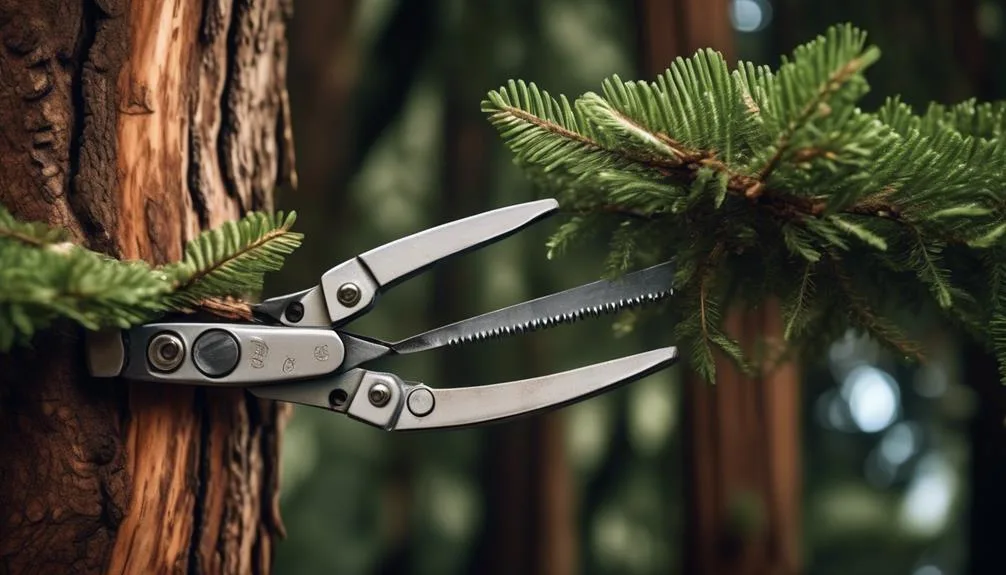Pruning redwood trees in your backyard can be a big task, especially when their branches start to get out of control. But don't worry, there are techniques to help you keep these majestic trees healthy and beautiful without causing any trouble.
Understanding the right timing, tools, and specific pruning methods is key. Let's explore the best ways to maintain the beauty and health of these towering redwood trees.
Timing for Pruning Redwood Trees
When is the best time to prune redwood trees for optimal health and growth?
Seasonal considerations play a crucial role in determining the best time for pruning redwood trees. Ideally, the best time to prune is during late winter or early spring when the tree is still dormant. Pruning during this time promotes new growth as the tree enters its active growing season.
It's important to avoid pruning in the fall as this can make the tree susceptible to winter damage. Additionally, refraining from pruning during the summer months is advisable as it can lead to excessive stress on the tree.
Proper Tools for Pruning Redwood Trees
Using the right tools is essential for proper pruning of redwood trees to ensure the health and longevity of the tree. When selecting tools for pruning redwood trees, consider the following:
- Pruning Tools:
- Sharp, clean pruning shears: Use bypass pruners for clean cuts, minimizing damage to the tree.
- Loppers: Ideal for trimming larger branches with precision, promoting proper healing.
Choosing the right tools not only benefits the tree's health but also minimizes the environmental impact. Dull or improper tools can cause damage to the tree, leading to potential disease and decay. By using the correct tools, you contribute to the overall well-being of the redwood tree and its surrounding environment.
Techniques for Pruning Redwood Trees
To ensure the health and longevity of your redwood tree, it's essential to understand effective pruning techniques that complement the use of proper tools.
When pruning redwood trees, it's important to consider the pruning height. Aim to remove dead, diseased, or crossing branches, but avoid excessive pruning, as redwoods are sensitive to over-pruning.
Additionally, when shaping your redwood tree, focus on maintaining its natural form rather than drastically altering its appearance. Pruning for tree shaping should be done sparingly, allowing the tree to grow in its characteristic majestic form.
When pruning, always make clean cuts just outside the branch collar to promote efficient healing and minimize the risk of disease.
Pruning Cuts for Redwood Trees
Consider making clean cuts just outside the branch collar when pruning redwood trees to promote efficient healing and minimize the risk of disease. This technique helps maintain the tree's health and appearance.
When making pruning cuts on redwood trees, keep the following in mind:
- Pruning Height
- When removing branches, cut just outside the branch collar to maintain the tree's natural shape and promote healing.
- Tree Health
- Avoid leaving stubs, as they can lead to decay and disease. By making clean cuts, you help the tree recover more effectively and reduce the risk of pests and diseases.
Following these pruning cut techniques won't only enhance the overall health of your redwood trees but also ensure they maintain their natural beauty and vitality.
Aftercare for Pruned Redwood Trees
After pruning your redwood trees, it's important to provide proper aftercare to support their recovery and promote healthy regrowth.
Tree maintenance is crucial during this period. Keep an eye on the trees for any signs of stress or disease, and promptly address any issues that arise.
Water the trees regularly, especially during dry spells, to ensure they've enough moisture for healthy growth. Applying a layer of organic mulch around the base of the trees can help conserve moisture and provide essential nutrients.
Additionally, consider using fertilizer specifically formulated for redwood trees to support their recovery after pruning.
Conclusion
Incorporating these pruning techniques will help maintain the health and beauty of your redwood trees.
Timing, tools, and proper methods are key for optimal results.
Remember to provide aftercare to support their continued growth.
Happy pruning, and may your redwood trees flourish for years to come.

My interest in trees started when I first saw the giant sequoias in Yosemite.
I was a teenager then, and I remember thinking, “I need to learn more about this.”
That moment stuck with me.
A few years later, I went on to study forestry at Michigan Tech.
Since graduating, I’ve worked in a mix of hands-on tree care and community education.
I’ve spent over ten years helping people understand how to plant, maintain, and protect the trees in their neighborhoods.
I don’t see trees as just part of the landscape.
They are living things that make a real difference in our daily lives.
